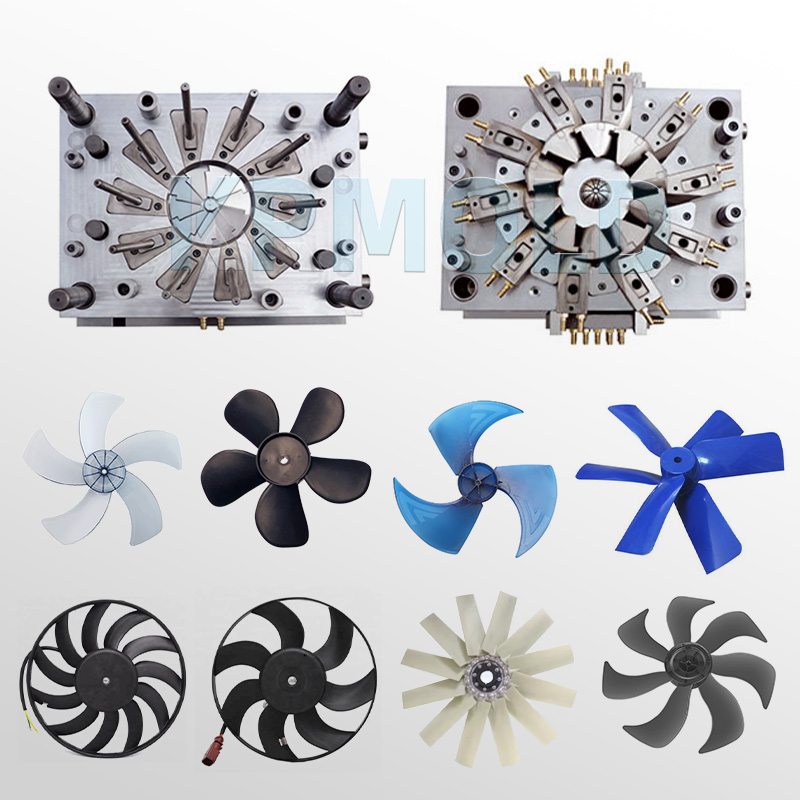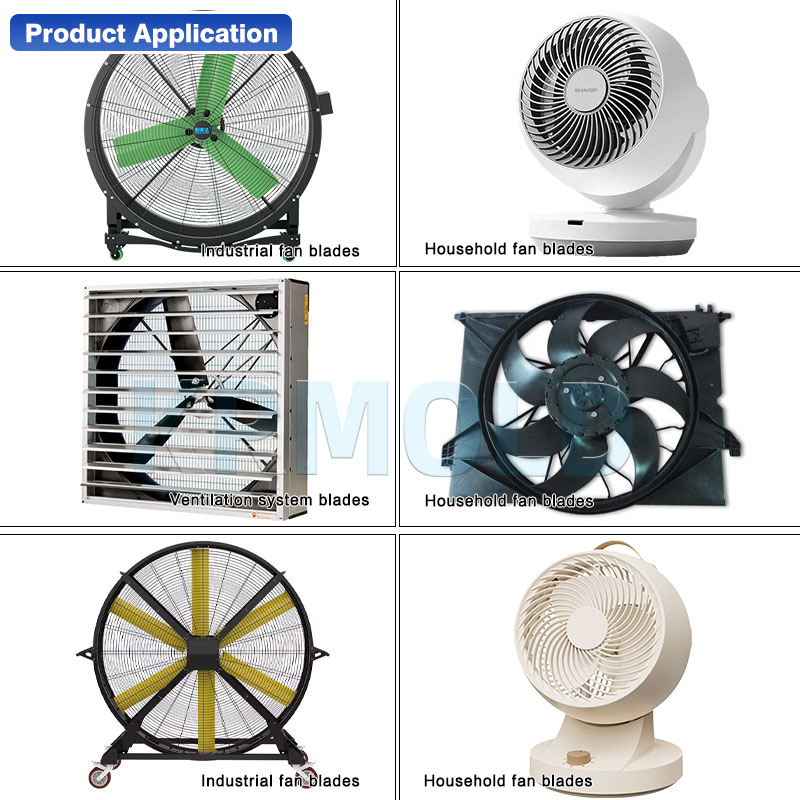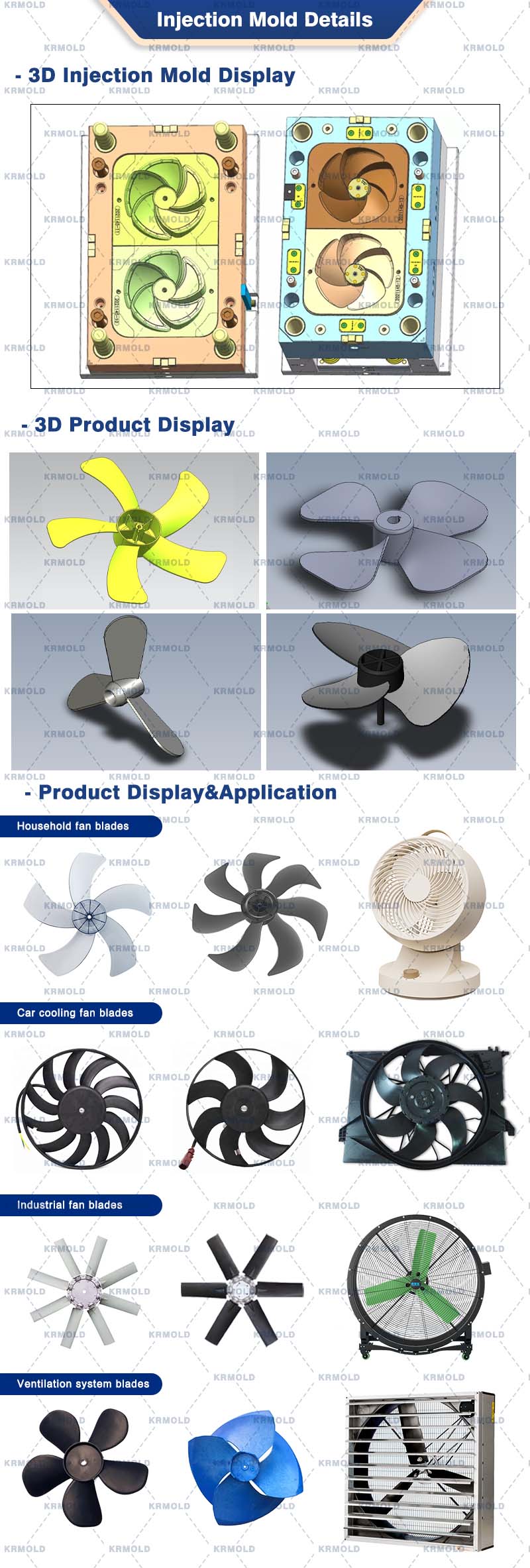
KINGREAL UNIVERSAL IND., LTD.
Telefon
+86-13702855825Fax
+86-20-22378259| 1 | Preparation Before Plastic Fan Blade Injection Mould Design |
| 2 | Key Technical Issues in Plastic Fan Blade Injection Mold Design |
| 3 | Plastic Fan Blade Injection Molding Process Parameters and Conditions |
| 4 | Material Selection for Plastic Fan Blade Injection Mould |
| 5 | Plastic Fan Blade Injection Mold Manufacturing and Commissioning |
Popular in the market and widely used in several sectors including home appliances and industrial gear, plastic fan blade injection molds are much sought after. Fan blade manufacture and design have also evolved alongside technology, so plastic fan blade injection moulding is a vital component of the production process. In this article, KRMOLD will provide a detailed introduction to the key factors to consider when designing plastic fan blade injection molds to ensure a rational design and efficient production. |  |
1. Preparation Before Plastic Fan Blade Injection Mould Design
Understanding the present market need for fan blades as well as their structure is critical before creating a plastic fan blade injection mold.
First one has to look up fan blade material, form, size, and operating environment.This knowledge will lay a crucial groundwork for upcoming mold construction.
1.1 Understanding Market Demand Fans are always changing to fit market demands in household appliances. Consumers, for instance, have higher expectations for fan efficiency and noise levels given growing knowledge of energy conservation and environmental preservation.Designing a plastic fan blade injection mold, therefore, calls for great attention to guarantee that it can create high-performance items meeting these standards.
1.2 Analyzing Structure of a Fan Blade The structure of a fan blade typically includes the tip, root, blade face, and blade back. Aerodynamic principles should be considered during design to optimize fan performance. The blade shape not only affects airflow but also fan efficiency, so it requires particular attention during plastic fan blade injection mould design. |  |
2. Key Technical Issues in Plastic Fan Blade Injection Mold Design
During the plastic fan blade injection mould design process, the coordination of components is paramount. The components must be properly coordinated to prevent collisions and ensure smooth mold operation.
2.1 Component Coordination and Fit
A plastic fan blade injection mold consists of multiple components, such as the cavity, core, cooling system, and injection system. The coordination and fit between these components is crucial. During design, 3D modeling should be performed using CAD software to ensure interoperability between components and avoid problems during actual production.
2.2 Flow Analysis During Plastic Fan Blade Injection Moulding Process
During the plastic fan blade injection molding process, the flowability of the plastic directly affects the molding quality. Flow analysis is necessary during plastic fan blade injection mould design to ensure uniform plastic flow within the mold and avoid air bubbles or defects.
Finite element analysis software can be used to simulate the flow conditions during the plastic fan blade injection molding process, thereby optimizing mold design.
3. Plastic Fan Blade Injection Molding Process Parameters and Conditions
3.1 Plastic Blade Design and Analysis The design of plastic blades is similar to that of metal blades, but due to the properties of plastic and the characteristics of plastic fan blade injection molding, special consideration must be given to plastic fan blade injection mould manufacturing technology and capabilities. The blade shape should be designed based on aerodynamic principles, but to simplify mold design, simplified design methods such as spatial helicoids or simulated curved surfaces are often adopted.
3.1.1 Blade Thickness Design The blade thickness should be designed based on the principle of thicker inside and thinner outside to improve structural strength and rigidity and ensure performance. Generally, the blade thickness should be adjusted according to actual usage to ensure stability and durability during use.
3.1.2 Blade Installation and Positioning The main body of the blade must be designed to ensure easy installation and positioning of the blade. Therefore, the center shaft should include an insert, and a mounting notch should be designed outside the hub to facilitate subsequent assembly and maintenance.
3.2 Injection Performance Analysis The feasibility analysis of the plastic fan blade injection molding process indicates that the part has a complex shape, uneven wall thickness, and requires high dimensional accuracy. Plastic fan blade injection moulding offers the following advantages:
Shape: There are virtually no restrictions on complexity, allowing the plastic fan blade injection mold to contain cavities for different plastics.
Size: Parts can weigh from a few grams to tens of kilograms, with virtually no restrictions.
Material: Suitable for thermoplastics with good flowability within a certain temperature range.
Precision: High-precision parts can be injected with good surface quality.
Productivity: Moderate, with cycle time primarily determined by part wall thickness and capable of being as short as a dozen seconds.
3.2.1 Surface Roughness and Dimensional Accuracy Based on the part's appearance, the exterior surface requires a high surface roughness (Ra 0.4mm), while the interior surface can be appropriately simplified (Ra 0.8mm). The plastic fan blade injection mould' roughness should be one to two grades lower than the part's, with a cavity surface roughness of Ra 0.2µm and a core surface roughness of Ra 0.4µm.
The dimensional accuracy requirement for plastic parts is Class 5. Specific dimensions and tolerances should be clearly indicated in the part drawing. Draft angle, wall thickness, ribs, and corner fillet design are also important factors affecting the performance of plastic fan blade injection molds.
3.3 Draft Angle and Wall Thickness Design Draft angle is crucial for ensuring smooth demolding of plastic parts. Plastic shrinkage is relatively low (0.2%-0.6%), so an appropriate draft angle should be adopted during design. Wall thickness should be designed to ensure uniformity to avoid warping or deformation caused by uneven wall thickness. |  |
4. Material Selection for Plastic Fan Blade Injection Mould
4.1 Characteristics of Plastic Materials
Plastics are solid materials made from organic polymers. Their advantages include low strength, high specific strength, and excellent electrical insulation. When selecting materials for fan blades, the following factors should be considered:
Good operating environment and use at room temperature.
High production volume with high quality and low price requirements.
Complex blade design and molding difficulties.
Good appearance and insulation properties are required.
4.2 Analysis of Common Plastic Materials
Common plastic materials include polyethylene (PE), polystyrene (PS), polypropylene (PP), and ABS. Each material has its own unique advantages and disadvantages:
Polyethylene (PE): Has good chemical stability and is suitable for low-temperature environments, but has relatively low mechanical strength.
Polystyrene (PS): Has good fluidity and is suitable for complex-shaped products, but is brittle and prone to cracking.
ABS: Offers excellent overall performance, strong impact resistance, and good dimensional stability, making it suitable for fan blade production.
4.3 Final Material Selection
Polystyrene and ABS seem to be the best materials for plastic fan blade injection molds in line with the foregoing assessment.Their little shrinkage helps to guarantee the performance and geometrical accuracy of the blade.
Moreover, ABS's capacity for large-scale manufacture derives from its good equilibrium of performance and production cost.
5. Plastic Fan Blade Injection Mold Manufacturing and Commissioning
5.1 Mold Manufacturing
The plastic fan blade injection mould manufacturing process includes material selection, processing technology, and heat treatment.
High-quality mold steel is selected to ensure mold wear resistance and longevity. During the manufacturing process, strict control of machining accuracy is required to ensure precise fit of all mold components.
5.2 Mold Commissioning
After plastic fan blade injection mould manufacturing is complete, commissioning is required. Setting up the injection molding machine, mounting the plastic fan blade injection mold, and doing mold trials form this process.Mold tests guarantee the final product satisfies quality specifications, let you check the plastic fan blade injection moulding results, spot and quickly fix any problems.